Important Adolphe Braun Auction Set for Paris on May 17th
Skinner Schedules Spring Prints and Photographs Auction for May 19th
Photography Book Reviews: Thiollier's 19th Century, Dawoud Bey's Community
Over 250 New Items Posted up for Sale on I Photo Central Web Site in Just the Last Few Months
New Special Exhibits Go up on I Photo Central
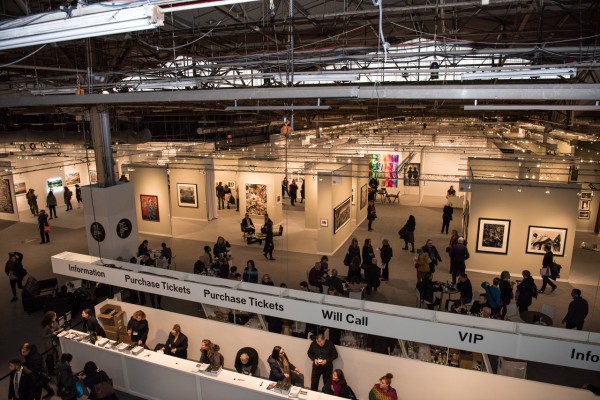
Entrance to the new AIPAD Photography Show on Pier 94. (Photo by Julienne Schaer)
Nothing could be more encouraging for fine-art photography than that it has outgrown its familiar environs. After a decade in the cozy confines of New York's Park Avenue Armory, AIPAD's Photography Show made the big move this year to the city's Pier 94 on the Hudson River, doubling in size and instantly turning an annual gathering dominated by insiders into something closer to a pop event--with all the splash and grandeur of a mega-museum exhibition, and all to the advantage of the dealers on hand.
Indeed, the Association of International Photography Art Dealers (AIPAD) got more than good reviews. Attendance was reportedly the highest in AIPAD's 37-year history, with more than 15,000 visitors (up from 12,000 last year) and 51 new dealers, bringing the exhibitor total to 119. That could only result in greater--and welcome--diversity, as galleries from Bangalore (Tasveer Gallery) to Belgium (Ibasho Gallery) and beyond delivered new sights and sensibilities to this sprawling survey of images from the 19th century through today.
"Clients have told me that The Photography Show looked incredible!" said Kraige Block, the new President of AIPAD and Executive Director of Throckmorton Fine Art, New York. Block, who headed up the team that designed the show, noted that clients were thrilled about the new bright look, spacious aisles and unique book section.
"The Photography Show’s move to Pier 94 brought with it both advantages and new challenges. The AIPAD organization did an incredible job bringing the fair to its new home with fantastic exhibiting galleries, wonderful special exhibitions, and dynamic programming. We congratulate AIPAD on its success," noted Christiane Fischer, President & CEO, AXA Art Americas Corp., which was the show's main sponsor.
For the first time, several major awards were made during the show. Maine Media Workshops + College awarded the The Arnold Newman Prize for New Directions in Photographic Portraiture to Daniella Zalcman (b. 1986), a documentary photographer based in London and New York. Finalists included Sophie Barbasch, Daniel Coburn, and Jessica Eve Rattner.
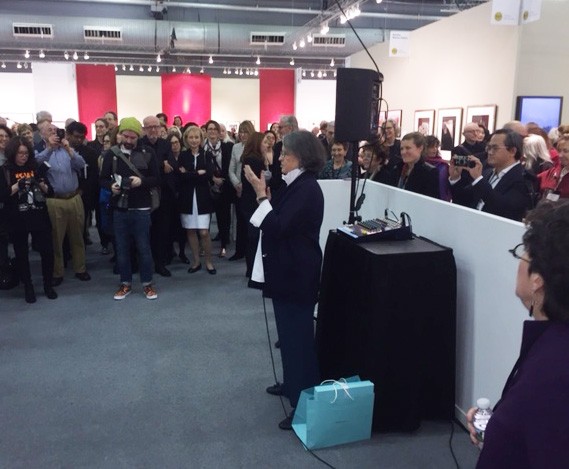
Anne Tucker and Sandra Phillips were the first two AIPAD award winners for their contributions and vision.
The new AIPAD Award, which honors visionaries who have contributed to the field of photography including artists, curators, publishers and others, was presented to Sandra Phillips, longtime curator of photography at the San Francisco Museum of Modern Art, and Anne Wilkes Tucker, founding curator of photography at Museum of Fine Arts, Houston.
If anything, the Pier 94 setting asked more of AIPAD than the usual dealer-driven fare--and more is what the show delivered, not only with its 16 well-attended, often sold-out AIPAD Talks with prominent curators (The Met's Jeff Rosenheim offered a fascinating preview of the upcoming Irving Penn survey), collectors, artists (including a session with Lee Friedlander and his wife, Maria, who described their life in art through the production of Friedlander's groundbreaking photo books), but also with its special curated exhibitions on loan from the collections of Artur Walther, Martin Z. Margulies and Madeleine P. Plonsker.
These curated shows-within-a-show imparted a welcome, museum-like quality to what is essentially a trade fair. The Margulies Collection, for example, surveyed the world--and the immense inequalities of the world--with photography-as-witness, from cultures as diverse as Nigeria (Pieter Hugo's "Heyerra Men of Abuja," in breathtaking digital C-print) and Russia (Anastasia Khoroshilova's portraits of female Russian soldiers), plus Simcha Shirman's austere images of Poland's concentration camp ruins, and the likes of Zoe Leonard's and Ralston Crawford's survey of poverty and isolation in the United States.
But it was still clearly the show itself that took center stage here.
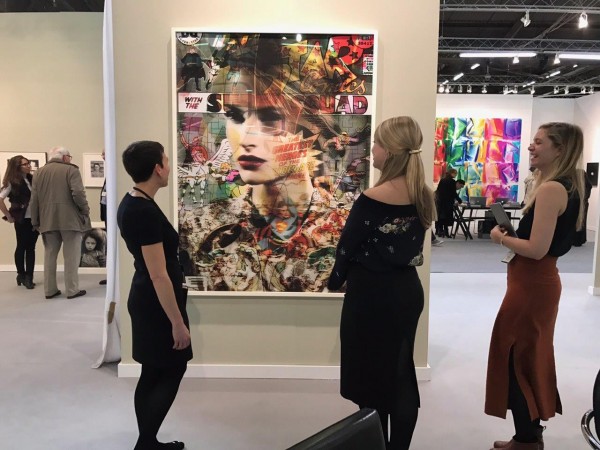
Big color in the Edwynn Houk Gallery booth. (Photo by Julienne Schaer)
Unquestionably, size matters in today's world of art collecting, as young, hip collectors seek wall art that makes a STATEMENT, while seasoned collectors recognize the value of scale even as they--and, to be fair, discerning younger patrons--appreciate the thinning, rarified ranks of vintage photography, from daguerreotype to tintype, ambrotype and the classicism of prints on paper. But the capacious display space allowed by the vast Pier 94 environment asked for scale wherever possible, and yet the balance of old, new, miniature and massive on display seemed right.
Fortunate to be right by the entrance to the show, San Francisco's Robert Koch Gallery was well-visited amid the show's Saturday afternoon high point. Koch had a mix of various modernisms, from Sudek and Dritikol to Moholy-Nagy and the striking and large Edward Burtynsky color prints of broken shipyards, suggesting a vague apocalypse that felt very much of the moment. Ironically or not, Robert Koch was feeling good about it all.
"After Trump was elected, it seemed the market fell off, as everybody was paying so much attention to TV," he observed. "But a show like this helps to widen the market for 19th century and contemporary. In a space like this, with this bigger audience, lots of Paris Photo exhibitors should be here now." As for 19th-century sales, Koch said that the "old guys" were still buying vintage, but "techies in San Francisco don't collect it. Museums are more the players in the 19th-century marketplace now."
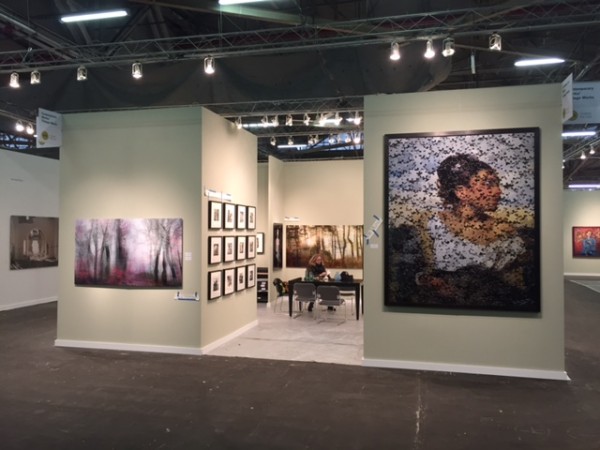
The Contemporary Works/Vintage Works booth had one of the largest images in the fair, the Vik Muniz of "Orphan Girl at the Cemetery, after Delacroix from Gordian Puzzles", as well as one of the smallest (a contact print by Andre Kertesz).
Adjoining Koch in a large, multi-sectioned display area even closer to the main entrance, Contemporary Works/Vintage Works, of Chalfont, PA, seemed to affirm that duality. Dealer Alex Novak grabbed the crowd's attention with walls dominated by the heat-seeking sensation of Robert Heinecken's "Erotic Cliches", the drama of Arthur Tress's vintage black and white squares, a large-scale color example from Tress's Roosevelt Island hospital installation series, and Vik Muniz's massive "Orphan Girl at the Cemetery, after Delacroix from Gordian Puzzles", while other walls bloomed with tightly groomed gardens of Brassai, Atget, Bravo, Kertesz, Kuhn, Penn and Man Ray prints. A room devoted to 12 works by Gustave Le Gray--from a wistful harbor image to great Parisian vistas--represented nothing less than the beginnings of fine-art photography in the 1850s and received attention in the full page New York Times article on the show.
Also making a strong impression at Novak's booth was the latest in photographic imagination by Lisa Holden, the British-born, Amsterdam-based artist who explores the slippery slopes of identity through a mixed-media blend of digital photography, paint and more. Holden herself appeared at Contemporary Works booth during most of the show.
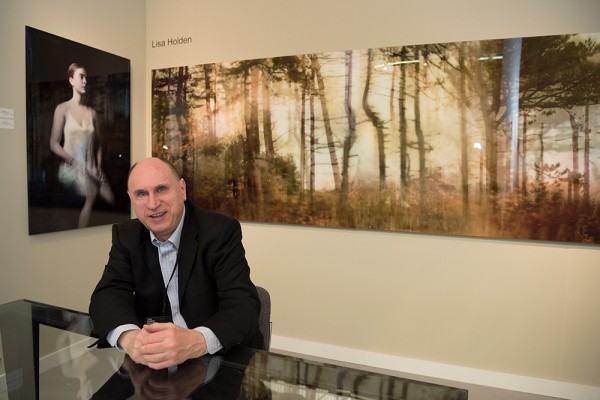
Exhibitor Alex Novak of Contemporary Works/Vintage Works in front of images by Lisa Holden. (Photo courtesy of Julienne Schaer and L'Oeil de la Photographie)
"Generally, it depends on the combination of drawing and photography," she explained to one of many intrigued visitors. "Once the image is right, I draw into it, also using varnishes, for example, to create textures." Holden's artistry is very much emblematic of AIPAD's fusion: utterly of today on one hand, yet washed in the tonal and thematic history of vintage photography, combining, for example, mythic feminine imagery with a sense of modern anxiety, fragmentation and freedom.
This fusion of the ultra-now and the timeless then was also riveting at the small booth taken by the boudoin lebon gallery of Paris, where artist Sacha Goldberger transfixed viewers with his "Super Flemish" series of superheroes from the Batman and Star Wars universes posed and photographed in capes, collars, and gilded raiments all tailored to evoke the painting of Flemish masters. The figures appear to be the actual Hollywood stars who play the superheroes--Christian Bale, Carrie Fisher, a menacing Heath Ledger as the Joker, a Wookie in ruffles--but it's all a careful matter of stage managing for ultimate effect.
"We look at about 110 people to find the right lookalike for each one," Goldberger explained. He was especially proud of a green-skinned stand-in for Lou Ferrigno's classic Hulk characterization, photographed seated in a dainty collar, glowering, with all his Hulkian rage barely repressed by European convention. "We research and work on these to try and feel how these superheroes would look and present themselves in the 16th century. It's a confrontation between pop superheroes and Romantic painting."
Of course, commanding attention at AIPAD is always a game of more is more, and this year's show had its share of viewer-stopping media installations, most impressively an 8-by-8-foot "Digital Wave I" installation by Clifford Ross, who occupied the entirety of New York's Ryan Lee Gallery booth with his computer-generated renderings of ocean waves displayed on a high-resolution LED video wall (available fully calibrated for the collector in the $200,000 price range). Ross also offers relatively more modest, though still monumental, black-and-white prints of oceanic drama--and in either case, the effect is intense and immersive.
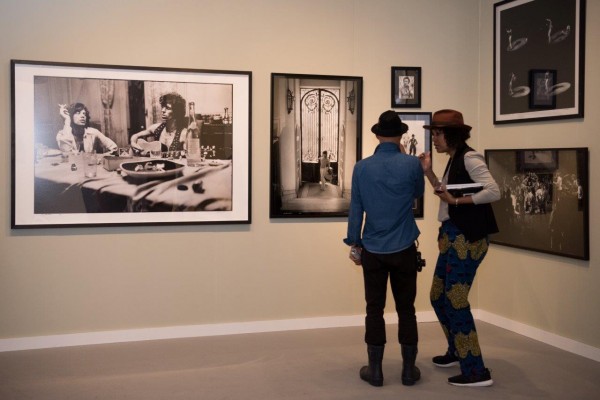
It's only rock and roll. (Photo by Julienne Schaer)
AIPAD is, after all, nothing if not a democracy of documentation. The stark images of dispossession, tribalism, or the despoliation of nature all coexist with the sights of vintage Pictorialism, the glamour and nostalgia of Harry Benson's shots of The Beatles, Bianca Jagger, Andy Warhol; Massimo Listri's huge empty interiors of classic Rome architecture; Stephen Wilkes' radiant day-long exposures, which expand the sense of time we experience when viewing the grandeur of world landmarks such as Stonehenge or the Arc de Triomphe.
These photographs, understandably, pop at us, but inevitably the smaller- scale treasures make their impression in a different way, as one leans toward what at first seems only slightly familiar. That's when Marianna Cook's shots of a young Michelle and Barack Obama in 1996, or Philip Johnson and David Whitney, or Maurice Sendak--all at Lee Marks Fine Art, out of Shelbyville, IN--please in their unassuming way. And one can get lost in Aldo Sessa's 1991 close-up view of the sheet-metal folds of the Statue of Liberty's robe, at New York's Throckmorton Fine Art.
Not surprisingly, the spectacle's sizzle translated into prime steak for many of the exhibiting dealers, and the sales reports were positive once the show concluded after a warm, good-weather weekend. "I could not be more thrilled with this year's AIPAD and believe the move to Pier 94 truly elevated the fair experience," said Bryce Wolkowitz, of Bryce Wolkowitz Gallery, New York. He reported strong sales including multiple works by Stephen Wilkes in the range of $15,000-$35,000, in addition to a Jim Campbell for $85,000 and a Robert Currie for $22,500.
"It was the best sales ever for me for any fair," said Steven Kasher, of Steven Kasher Gallery, New York. Monroe Gallery, Santa Fe, reported that they "love the new venue and that the show looked impressive," and commented on the "great traffic, including museums, collections, and first time buyers." They sold more than 40 photographs.
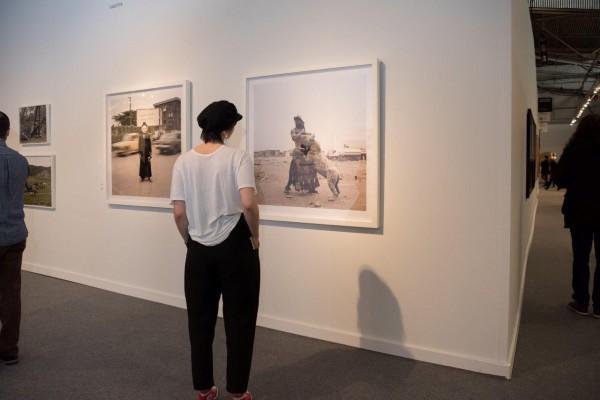
(Photo by Julienne Schaer)
Yancey Richardson Gallery, New York, reported that, "It's been a very good fair for us. We sold across the board including work by Mickalene Thomas, Zanele Muholi, Paul Mpagi Sepuya, and Olivo Barbieri. All the curators attended."
The Photographers Gallery, London, sold nearly 20 photographs, including Terence Donovan's work comprised of 144 vintage contact photographs in one frame for over $40,000, and saw a real mix of art consultants, gallerists from out of town, museum curators, and serious collectors.
Hans P. Kraus Jr., New York, reported an excellent fair with sales of an 1857 Gustave Le Gray and an 1846 Rev. Calvert Richard Jones, both at $60,000, among others. Vasari, Buenos Aires, saw a number of new collectors and existing clients, and sold an Annemarie Heinrich silver print for $15,000, a Grete Stern silver print for $25,000 and an Alicia D'Amico print for $7,000, among others.
Stephen Daiter Gallery, Chicago, sold work including three Sid Grossman Coney Island photographs from 1947-48, a Harry Callahan work from 1943 and a László Moholy-Nagy photogram, and remarked on the strong number of institutions and seasoned collectors at his booth.
Richard Saltoun Gallery, London, saw many museum and private collectors and sold over 20 photographs including an Alexander Rodchenko work for $15,000, a 1962 photogram by Bela Kolarova for $14,000, and an Eve Arnold print for $5,000. Tiwani Contemporary, London, sold work by Dawit L. Petros and said the fair was excellent for meeting institutions.
What's encouraging about the latter is that Tiwani Contemporary was featured in the show's other new dimension, the Discovery section, where less established dealers occupied small booths with one or two artists on display. Petros, an Eritrean now based in Chicago, is a poet of color and politically charged imagery, as in his stunning shot of a black man carrying a large bag over a Moroccan horizon, having walked through a field of cactuses that overwhelm the image's foreground. Form, meaning, vision--powerfully combined. Such discoveries are really what AIPAD is, or should be, all about. Now that it has made its move, aggressively and amazingly, into one of New York's biggest arenas, it should spark greater discovery every bit as much as it seeks higher dollars.
Matt Damsker is an author and critic, who has written about photography and the arts for the Los Angeles Times, Hartford Courant, Philadelphia Bulletin, Rolling Stone magazine and other publications. His book, "Rock Voices", was published in 1981 by St. Martin's Press. His essay in the book, "Marcus Doyle: Night Vision" was published in the fall of 2005.
He currently reviews books and exhibits for both the E-Photo Newsletter and U.S.A. Today.
Important Adolphe Braun Auction Set for Paris on May 17th
Skinner Schedules Spring Prints and Photographs Auction for May 19th
Photography Book Reviews: Thiollier's 19th Century, Dawoud Bey's Community
Over 250 New Items Posted up for Sale on I Photo Central Web Site in Just the Last Few Months
New Special Exhibits Go up on I Photo Central


Share This